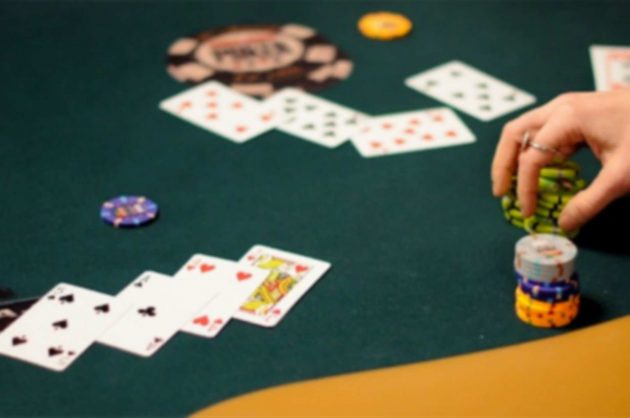Deuce to 7 Stud is a variation of razz, where the lowest five-card hand wins the pot. Deuce to 7 Stud is a variation of razz, where the lowest five-card hand wins the pot. The basic difference between the two games is that, whereas in razz, straights and flushes do not count against your hand, and the lowest possible hand is A-2-3-4-5 (aces being low in razz), in deuce to seven, straights and flushes are taken into account when looking at the hand, and aces are high, so the best possible hand is 7-5-4-3-2, where at least one card is of a different suit than the others.
The hand is dealt exactly like any other 7 Card Stud game, with an ante prior to the deal, and then three cards dealt out, one at a time, two face down and one face up (the “door” card). The highest card showing is then forced to start the betting with a “bring-in” bet, which is a percentage of whatever the limit for that betting round is. If there are two cards of the same denomination qualifying as the bring-in, the order is determined by suit, spades being the highest—spades, hearts, diamonds, clubs.
There is a full betting round (usually with a maximum of three raises) after each subsequent card is dealt. When the fifth card is dealt, the betting limit doubles and remains there for the rest of the hand. The seventh card is dealt face down, just as in most 7 Card Stud games.

In betting rounds following the fourth through seventh cards, the player with the lowest hand showing starts the action, and may check or bet. Once all seven cards have been dealt and the final betting round is complete, the hands are compared, and the lowest five-card hand, with no straights or flushes, is the winner. The hands are judged by highest card, regardless of the other cards in the hand. If two or more players have the same high card, the next highest card is examined, and so on. For example, 8-6-5-4-2 is better than 8-7-4-3-2. If every hand has at least one pair, the lowest pair is the winner. As such, for you to be successful in this game, you need to be strategic just like what you need when playing agen bola terpercaya.
This game is rarely played except in home games or in very high limit casino poker games. When Deuce to 7 is played in tournaments and online, it is usually played in a triple-draw format, where each player has the option to discard as many card as he/she wants in three separate drawing rounds. The game is also played in a single draw, no limit format, which is considered one of the hardest games to master, due to the incredible amount of bluffing and counter-bluffing that takes place among top-level players. Prior to the advent of the $50,000 HORSE championship at the World Series of Poker, many top professionals considered the Deuce to 7 championship bracelet to be the second-most prestigious one to win, after the Main Event.
As with Razz, strategy in Deuce to 7 stud revolves mostly around the cards showing on the board, although the necessity to avoid straights and flushes adds a bit of complexity to judging your opponents’ hand strengths. The first thing a player should do is to look and see what other cards have been dealt other than his/her own. If all the other cards are “paint” (picture cards), and you are dealt a deuce, you can often take the pot down right away with an aggressive bet.
In making a hand, there are a few general considerations that a player should adhere to. The first is the power of the deuce in this game. In addition to the fact that the lowest possible hand can’t be made without a deuce, the deuce also only has one card (the three) with which it combines to make a straight. Therefore, it is much easier to avoid a straight when you hold a deuce in your hand. As the hand progresses, it is important to examine all the cards that are present on the “board” (face up), in order to see which of the cards that would make your hand are already out in someone else’s hand.
A good starting hand would be three cards to an 8 or 9, especially if the highest card is hidden, and other players don’t have good cards showing. It is better to have the cards somewhat spread out, which helps avoid hands turning into straights. For example, a 7-4-2 would be a much better starting hand than 6-5-4, partly because the former hand is three parts of the absolute best hand possible, and partly because the latter hand is hard to complete without catching a straight.

As the betting rounds progress, be aware of your opponents’ boards. If you are heads-up with a player who pairs his door card on fourth street, or hits a very high card, and you are showing two small cards, you need to get money into the pot, as you are likely to take it down right there. As always, knowing the other players, and how far they will chase a hand that hasn’t yet developed, is essential to knowing whether you can bluff a player when you yourself have paired one of your hidden cards.
While Deuce to 7 stud doesn’t have nearly as much bluffing as its draw counterparts, you can use a strong-looking board to bully your opponents into folding their hands. As the hand plays out, you will usually have a very good sense of whether you are ahead or behind, and can act accordingly. When you know you are ahead, it is essential to keep betting, and force the other players to pay for the chance at drawing out on you. The only exception is if you hold an unbeatable hand by the fifth card, in which case you can sometimes vary your play and slow down, hoping your opponent makes a second-best hand from which you can collect more later on in the hand.
If you have a home game, Deuce to 7 stud can be an enjoyable and challenging game to throw into the mix from time to time, especially if no one else is familiar with it. Home game players always enjoy learning new games, and this one is well worth the few minutes it will take to explain.

